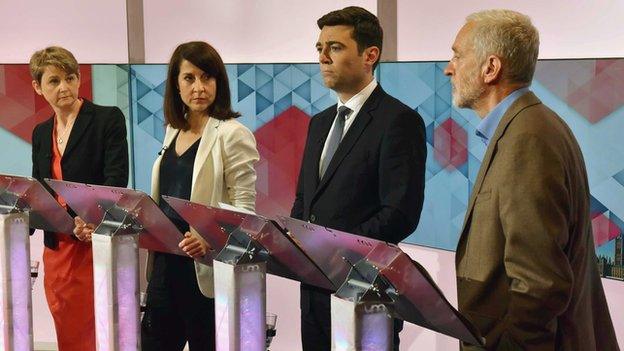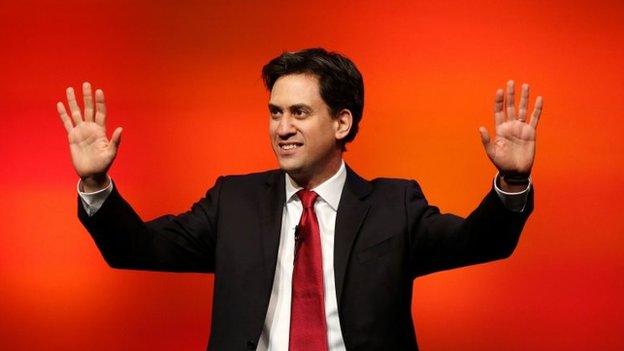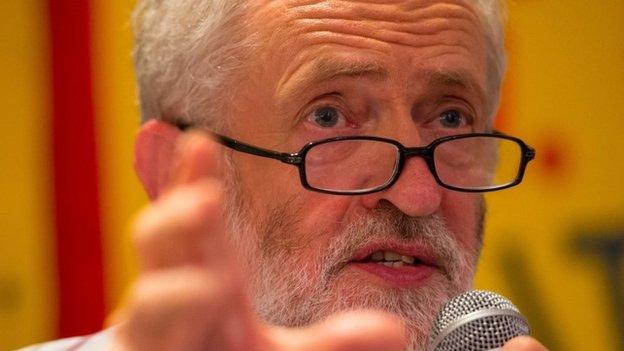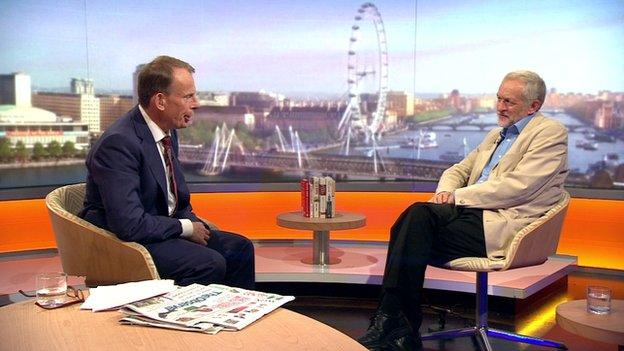How is Labour vetting new members?
- Published

One Tory MP has been caught trying to register in order to vote for left-winger Jeremy Corbyn (right)
The Labour Party insists it has "robust" procedures to prevent its leadership election being sabotaged by members of other parties. So what is it doing?
The party has more than doubled in size since the general election, with a massive influx of new members and registered supporters eager to take part in its leadership election.
Many of those new members are thought to have got on board to cast a vote for left-winger Jeremy Corbyn, who is touring the country to halls packed with fervent supporters.
Some Labour MPs have raised concerns about members of rival parties, who believe Mr Corbyn would be a disaster for Labour, joining up to vote for him. One Conservative MP suspected of doing this has already been caught out.
There are also fears among centrist Labour figures that members of hard left groups - who previously did not have their views represented at the top of the Labour Party - are joining up in a new bout of "entryism," of the kind that plagued the party in the 1980s.
Then Labour leader Neil Kinnock fought a long battle with the Militant Tendency, a group accused of attempting to infiltrate the party and gain key positions to further its revolutionary socialist agenda.
'Witch hunt'
The Trade Union and Socialist Coalition, which includes the Socialist Workers Party and which stood against Labour in 135 seats at the general election, has dismissed claims of entryism as a Blairite fantasy.
Left Unity, a left wing party founded by film director Ken Loach, which fought 10 seats in May, has complained of a "witch hunt".

Socialist groups are urging their members to vote for Jeremy Corbyn
It said Labour should be "thrilled" so many people wanted to join rather than focus on "people who it thinks are too left wing".
The sheer scale of the surge in Labour's membership - it has gained 79,000 members since the general election and 145,000 registered supporters - and the relatively small numbers of people who make up the membership of the UK's many fringe left wing parties suggest entryism fears may be overblown.
A Labour spokeswoman said there was a robust system in place to prevent fraudulent and malicious applications and additional checks were being carried out to make sure the rules are upheld.
Asked if these had been introduced because of concerns of infiltration by supporters of other parties, she said the verification process was kept under constant review and the new checks had been introduced in the past few weeks.
'Very confident'
An exclusion list is being drawn up of those who have stood against Labour in the past or helped others to oppose the party.
The BBC understands that up to 1,000 applications have been rejected.
The spokeswoman said there was a staff of 40 in Newcastle and 30 at Labour HQ in London working to verify and check applications.

Ed Miliband introduced Labour's new voting system
MPs, local constituency parties and regional offices are also carrying out checks and providing further information. Applicants' social media records are being checked too.
The spokeswoman said the party was "very confident" the process would detect a large proportion of the bogus applications. She said there were no plans to suspend or halt the leadership contest, as some Labour MPs, such as Barry Sheerman, are demanding.
But without access to other parties' membership lists it is impossible for the party to know for certain the backgrounds of every new supporter.
Anyone can apply to vote in the Labour leadership election, if they sign up as a party member or supporter by Wednesday's deadline.
To be a "registered supporter" all that is needed is to pay £3 and tick a box agreeing that you believe in the "aims and values" of the Labour Party.
Mammoth task
Once you've done that an automated email is sent to your email address and the application comes through to the Labour office in Newcastle, where staffers check your details on the electoral registers, run a Google search and then identity if you are a "known" person who has been a candidate or local activist for another party.
You can also be recruited as an "affiliated supporter" on the telephone - 80% of the calls are checked and verified by Labour staffers. If any call in a "batch" shows any problems all the calls will be double-checked by the party.
Vetting the details of new applicants by the 10 September voting deadline is a mammoth task.
There are now 280,000 full members, 80,000 affiliated supporters and 65,000 registered supporters.
That makes the total size of the electorate 425,000 and counting.
Labour insists its vetting system is more secure than the one used in the 2010 leadership election, when ballot papers were sent to more than two million people, the majority of whom were members of affiliated trade unions.
There was no verification process or checking and the party says many of those ballots will have gone to members of other parties and they have no way of knowing who voted in the contest.
That system was scrapped by the man elected under it, Ed Miliband, with the backing of party members.
Additional reporting: Jack Evans.
- Published10 August 2015

- Published7 August 2015

- Published26 July 2015
